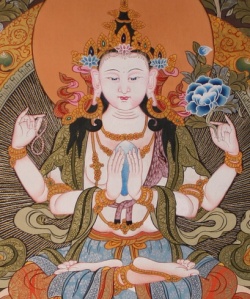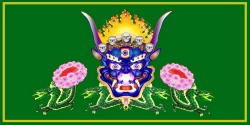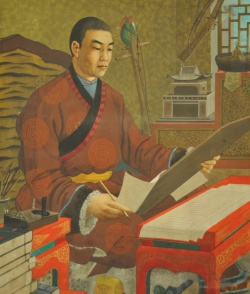Summary of Tendai esotericism/Taimitsu
Taimitsu 台密. The esoteric practices and teachings of the Japanese Tendai school 天台 associated with Enryaku-ji 延曆寺 at Mount Hiei 比叡山 and Onjō-ji 園城寺, which stands in contrast to that of Shingon 真言 as transmitted by Kūkai 空海, called Tōmitsu 東密, which is associated with Tōji 東寺.
Tendai is comprised of four primary elements including those of Chinese Tiantai 台, the esoteric 密, Chan 禪 and the vinaya 律.
The esoteric teachings were initially brought over by Saichō 最澄 and thereafter Ennin 圓仁 and Enchin 圓珍 in the ninth century before being consolidated by Annen 安然.
Saichō (in China 804-805) received the vajra and garbha maṇḍalas 金胎兩部 from Shunxiao 順曉 at Lingyan-si 靈巖寺 in China, thereafter establishing Tendai upon returning to Japan. In 805 at Takaosan-ji 高雄山寺 he carried out the first initiation 灌頂 (abhiṣeka) in Japan.
The following year he established a training program utilizing shikan 止觀 (the complete teachings of Tiantai 天台圓教) and shana 遮那 (esoteric teachings 密教) as detailed in his Sange gakushō shiki 山家学生式 (818-819).
Ennin was in China between 838-847 and received teachings, texts and initiations from figures Quanya 全雅, Yuanzheng 元政, [[Zhen'a] 真阿 and Faquan 法全.
Enchin likewise went to China between 853-858, studying under *Prajñātra 般若怛羅, Prajñācakra 智慧輪 and Faquan.
His views differed from Saichō and Ennin in that he taught a difference between the complete and esoteric teachings, favoring the esoteric over the exoteric. Annen (born 841), a disciple of Ennin, formulated a systematic vision of Taimitsu while refuting Kūkai and other schools.
Taimitsu is organized around the whole of Buddhadharma, called the 'union of the complete and esoteric teachings' 圓密一致 where Mahāyāna sūtras such as the Avataṃsaka-sūtra 華嚴經 (T 279) and Lotus Sūtra 法華經 (T 262) are regarded as 'esoteric in principle' while scriptures such as the Mahāvairocana-sūtra 大日經 (T 848),
Vajraśekhara-sūtra 金剛頂經 (T 874) and Susiddhi-tantra 蘇悉地經 (T 893) are regarded as 'fully esoteric in principle and practice'. Tōmitsu in contrast strictly differentiates between the esoteric and exoteric 密顯, regarding the former as superior to the latter.
Taimitsu comprises all three aforementioned esoteric texts plus the Putichang suoshuo Yizi ding lunwang jing 菩提場所說一字頂輪王經 (T 950) and Yuqi jing 瑜祇經 (T 867) – altogether called go bu mikyō 五部祕經 – whereas Tōmitsu focuses on only the first two.
Taimitsu regards Mahāvairocana 大日如來 as the dharmakāya 法身 of Śākyamuni Buddha 釋迦牟尼, whereas Tōmitsu regards them as different.
Taimitsu advocates the doxography 教判 of Chinese Tiantai where the three teachings 天台三教 (the Tripiṭaka doctrine 藏, intermediate 通 and differentiated 別) are regarded as exoteric with the complete teachings 圓教 in principle being esoteric. In contrast, Kūkai's ten mental stages 十住心 list nine exoteric stages and one esoteric.
As to commentaries on the Mahāvairocana-sūtra 大日經 (T 848), Taimitsu is based on the Darijing yishi 大日經義釋 [Z.36.507ff] while Tōmitsu the Darijing shu 大日經疏 (T 1796).
Taimitsu's other key commentaries include Ennin's Kongōchō kyō sho 金剛頂經疏 and Soshitchi kyō sho 蘇悉地經疏, Enchin's Bodaijō kyō ryakugi shaku 菩提場經略義釋 and Annen's Yugi kyō gyōhō ki 瑜祇經行法記, together called the five great commentaries 五大疏.
Taimitsu flourished in the Heian 平安 period (794-1185), though late in it it fractured into the thirteen currents of Taimitsu 台密十三流. Three originally from the three who went to the Tang:
Konhon-daishi-ryū 根本大師流 (Saichō), Jikaku-daishi-ryū 慈覺大師流 (Ennin) and Chishō-daishi 智證大師 (Enchin).
Within the Jikaku-daishi-ryū there formed the Renge-ryū 蓮華流, Inson-ryū 院尊流, Sanmai-ryū 三昧流, Bucchō-ryū 佛頂流, Ajioka-ryū 味岡流, Chisen-ryū 智泉流, Anou 穴太流, Hōman-ryū 法曼流, Kudoku-ryū 功徳流 and Nashi no Moto-ryū 梨本流.


